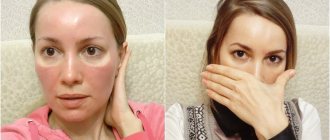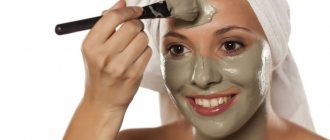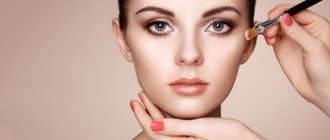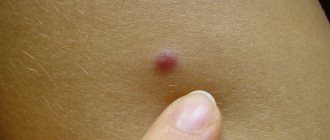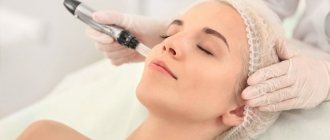Modern cosmetics are very diverse in composition, and it so happens that a new mask suddenly produces an unpleasant result - a red face after a mask, skin irritation, an allergy to clay. What to do in this case and what could be the reason? Despite the fact that the result is the same: after application the face turns red, it can be caused by various reasons.
What you will learn:
- Causes of facial redness after a mask Allergy to clay
- Features of the mask
- Skin irritation
- Poorly cleansed skin or dirty hands
- What to do to avoid redness
Causes of facial redness after a mask
Allergy to clay
This option is especially likely when the mask is new and has not been tried before. If your face is red and itchy, it may be an allergy to one of the components of the mask.
You should not immediately dismiss this option, even if the mask was recommended by a friend whose cosmetics did not cause any consequences. It is important to remember that all people have different skin and body characteristics, so it is quite possible that the mask will suit someone without problems, but will cause an allergic reaction in others.
The product has already been used before and did not cause any complaints, but suddenly your face turns red after the mask? It could still be the same allergy. It happens that during chemical processes in the body, some component may begin to cause allergies, although there were no such reactions before.
Features of the mask
Some products have a certain effect , after which it looks red for some time.
But this is an absolutely normal effect, and soon the redness will disappear on its own, so there is no need to panic or get upset, you just have to wait. In addition, the mask can cause a rush of blood to the skin due to its warming effect - hence the redness, which, in this case, is also completely normal.
Skin irritation
For various reasons, irritation may occur , causing redness. Some components of natural masks can slightly scratch the skin, hence the appearance of irritation. In addition, if the mask is not suitable for your skin type and, for example, dries it out, this can also cause a similar effect.
Poorly cleansed skin or dirty hands
Redness and irritation can be caused by simple lack of hygiene. If you do not cleanse your face before applying a mask or carry out the procedure with dirty hands, this can cause tiny particles of dirt to get into the enlarged pores of the face and, as a result, redness and inflammation on the skin.
The main symptoms of an allergy to a mask!
- Redness and swelling of the skin;
- The appearance of acne and various rashes, which can merge, forming spots of different diameters;
- Sneezing, coughing, lacrimation, shortness of breath, feeling short of air, asthma attacks;
- Headache, elevated body temperature, discomfort.
A regular single-layer mask is not designed to protect against allergens and allows large particles (dust, allergens) to pass through. Since condensation accumulates in it when worn, seasonal allergies develop faster and have more severe manifestations than usual.
Before purchasing a medical mask, you need to familiarize yourself with its composition. It is necessary to make sure that it does not contain harmful substances both in the composition of the fabric and in the interlayers used as a filter.
Types of masks and the type of reactions they can cause
Depending on the type of mask, the most likely causes of redness may be different, therefore, the answer to the question - what to do if your face turns red after a mask will be different.
Masks with natural herbal ingredients
Such masks often cause allergic reactions, and if after the mask the redness does not go away and causes itching and burning, it means that some of the components caused the allergy. It is virtually impossible to predict in advance what is in the composition of the product that is responsible for the reaction.
However, it is worth noting that essential oils often cause allergies or irritation, so if your skin is sensitive, you should be careful with such masks.
In addition, natural ingredients expand pores and give a warming effect, so, for example, after a mask with honey or a mask with bodyaga, temporary redness of the face is normal.
Clay masks
Clay is often used for various masks, and its use is quite justified - this natural material has many beneficial properties . However, what to do if your face turns red after a clay mask?
What is the reason?
- Allergy to clay. You may also experience an allergic reaction to this product. It is also possible that an allergy will be caused by one type of clay, while others will be perceived as absolutely normal. This is due to the different composition of clay varieties.
- Natural reactions. Clay cleanses the skin, but can be slightly drying or tight, hence the red face after the mask. If your face turns red after a clay mask, but the redness is not too strong and does not cause discomfort, most likely it will disappear on its own in a couple of hours.
What to do?
Let's try to figure out what to do if your face turns red after the mask:
- Try lubricating your skin with Panthenol or Bepanten. This is a safe pharmaceutical cream that contains dexpanthenol, a derivative of one of the B vitamins. This substance effectively accelerates skin restoration, helps increase the density of collagen fibers, and also optimizes metabolism in cells. Creams with dexpanthenol are often used in the treatment of skin diseases and burns.
- You can also apply a regular moisturizer or nourishing cream to the skin.
- If there is severe itching and other symptoms of an allergic reaction, take any antihistamine, for example, Loratadine, Cetrin or Zyrtec in the amount of one tablet. Such drugs effectively eliminate the symptoms of individual intolerance in literally half an hour to an hour.
- If you suspect an allergy, do not use clay masks anymore.
- If there are no allergic manifestations, check how suitable the chosen product is for you. In particular, owners of combination skin should use some drying and deep cleansing compositions only on the T-zone, and on the cheeks such masks will naturally cause irritation.
If redness of the epidermis is a natural non-allergic reaction of the skin to clay, try to make the mask in the evening. Then the skin will have every opportunity to recover before morning.
Masks for chemical and mechanical peeling
Mechanical peel masks contain particles that can scratch the skin. This could be, for example, parts of an apricot kernel, pumice stone or grains of salt. Therefore, if your face turns red after a mask, most likely your delicate skin reacted with irritation to such exposure.
Chemical masks differ in the content of acids, which, although small, can still cause a chemical burn. In this case, the redness resembles sunburn.
What to do to avoid redness
To avoid unpleasant redness on the skin caused by the use of masks, you need to follow some recommendations.
- In case of allergies, you should consult a dermatologist - the doctor will tell you what could be the cause, and also prescribe medications to relieve symptoms. Of course, you need to avoid masks with the component that causes allergies and carefully study the composition.
- Select masks that suit your skin type.
- Before using the mask, you need to apply a little to a small area of skin on your arm and wait. If everything is in order, you can safely use the mask, but reddened skin or itching will warn you that it is better not to use the mask.
- Follow simple hygiene rules, clean your face before applying the mask and wash your hands.
- For delicate skin, it is better to choose masks that do not have too strong an effect.
- Follow the mask instructions if provided. Redness may appear because the mask has simply been left on the face for too long.
- Take care of your skin in a timely manner, using emollient creams and lotions appropriate to your skin type.
Following these simple tips will help you avoid redness on the skin associated with the use of masks, keep your skin healthy, and if trouble does occur, quickly deal with the consequences.
Causes of acne on the face from wearing masks
If, after wearing a mask for a long time and frequently, acne begins to form, the cause of the rash may be as follows221:
- Restricting the flow of air to the skin and creating a “greenhouse effect”. Under the mask, the local temperature increases, which leads to disruption of the normal skin microbiome. The growth of pathogenic microflora, including propionibacteria, which provoke acne, leads to exacerbation of acne.
- Changes in the permeability of the skin's protective barrier. The skin sweats more, which acts as an irritant, not only exacerbating acne, but also causing itching and erythema. A moist environment is created under the mask, again favorable for the proliferation of pathogenic bacteria.
- Friction of the mask on the skin. Mechanical impact leads to irritation and injury to the epidermis.
- Stress. The need to wear a medical mask, like the entire pandemic situation, has unsettled many. Against the background of stress, hormones are produced that provoke an increase in sebum production, which is one of the main links in the pathogenesis of acne.
Constantly wearing a protective mask provokes an exacerbation of other skin problems. In the clinical picture of patients seeking help, specialists detect peeling, itching, and redness. Sensitive skin becomes even more sensitive, and oily skin produces even more sebum.
Acne on the chin: the reason is the wrong mask
To minimize the harm of a mask to facial skin, you need to choose this medical accessory correctly. Scientists have found that surgical masks provoke the most unwanted reactions in the form of exacerbation of acne and the appearance of new rashes. Most of them consist of several (3-4) layers of fabric, which are supplemented with filter sheets. They create an occlusive effect, do not allow air to pass through well, and do not allow moisture to evaporate.
It is recommended to switch to fabric masks made from cotton, polyester, and silk, which allow the skin to “breathe.” In addition, it must be changed every 4 hours. Reusable masks need to be washed after each use, while disposable masks must be thrown away after removal and cannot be reused.222
How to properly apply a clay mask to your face
Before applying the clay composition to the skin of the face, you will need to thoroughly cleanse the pores. The clay itself is diluted with cool water, with constant stirring, since there should be no lumps in the mass. As a rule, clay is diluted to the state of sour cream. To be more precise, when applied, the composition should not flow over the face, since it must be distributed evenly over the entire area of the face.
If you make the mask too thick, it will harden quickly and will not give the desired effect, but if it is too liquid, then it will simply drain.
The mask is applied to the entire face, except for the eyes, since there are no sebaceous glands on their skin, and the mask will have the opposite effect. The procedure is carried out in a horizontal position of the body, and this is not just a recommendation, but part of the correct instructions. Clay is considered a heavy material, and therefore if you sit while wearing a mask, it will pull back the skin and muscles of the face, which is naturally not required.
See also
An incomparable face mask made from oatmeal at home - an ambulance for the skin
Gel Klindovit® in the fight against acne
If it was still not possible to prevent the appearance of acne, it is necessary to deal with it correctly. You should consult a cosmetologist or dermatologist who will recommend proper skin care and medications to combat rashes. Whatever the main causes of acne, it is a disease that requires proper treatment.
For mild to moderate acne, Clindovit® gel can be used. This is a topical antibiotic that should be applied to the skin 2-3 times a day. The face must first be cleaned. The composition of Clindovit® gel includes clindamycin phosphate. This is an antibiotic lincosamide, which has antimicrobial activity against propionibacteria, which cause acne.6, 18
